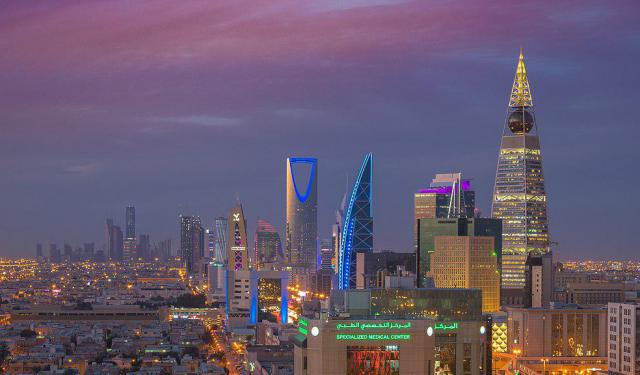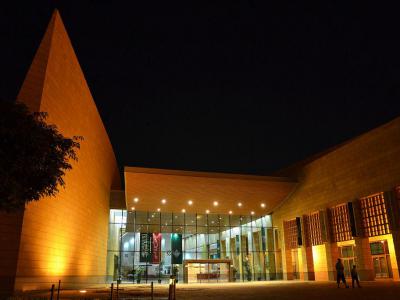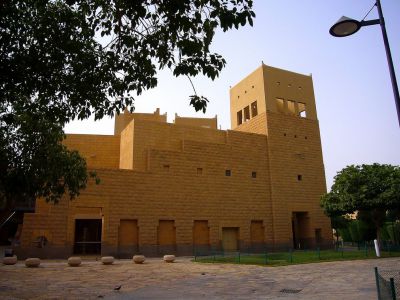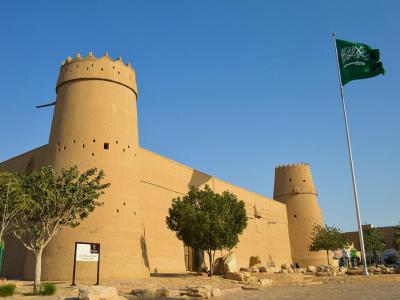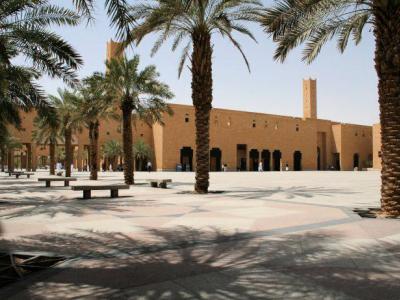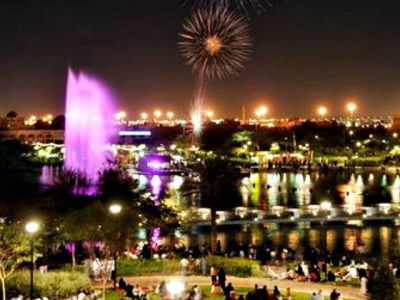Riyadh Introduction Walking Tour (Self Guided), Riyadh
Wise men say that the beauty of a city is not defined only by its length, width, and the grandness of its buildings, but by the broadness of its vision and the height of its dreams. Indeed, whoever envisioned today's Saudi Arabian capital Riyadh – poetically described as the place "where the sands meet skyscrapers," – must have dreamed big and wide!
The stark contrast between the surrounding desert and the impressive urban landscape makes it hard to imagine that some 100 years ago, on the site of this vibrant, fast-growing metropolis, was a small town with a population of just 18,000 people.
Riyadh's history dates back several centuries. Originally, it was a small walled settlement known for its palm groves and fertile land. The name "Riyadh" is derived from the Arabic word "rawḍah," which means "garden" or "meadow" and reflects the historical abundance of palm trees and lush vegetation in the area. Riyadh is also sometimes referred to as "Riyadh Al-Masmak," after the iconic Masmak Fortress located in the city.
In the 19th century, Riyadh became the capital of the First Saudi State during the reign of Imam Turki bin Abdullah Al Saud. In 1902, Abdulaziz Ibn Saud, the founder of modern Saudi Arabia, began a campaign of unifying the Arabian Peninsula under his rule, which saw Riyadh as the center of his political and military activities. Riyadh developed culturally, but especially economically, beginning in the 1950s, when the petroleum industry boomed.
The King Abdulaziz Historical Center, incorporating the King Abdulaziz Library, the National Museum of Saudi Arabia, and Murabba Palace, offers a glimpse into Saudi Arabian heritage, art, and culture. Another local landmark, the Imam Turki bin Abdullah Mosque is a prominent historic, religious, and architectural site.
Almaigliah Souq is a traditional market located in the historic Al-Masmak neighborhood of Riyadh; whereas Salam Park, also known as King Fahd Park, is a popular green space in the city.
American novelist Roman Payne wrote: "Cities were always like people, showing their varying personalities to the traveler. Depending on the city and on the traveler, there might begin a mutual love, or dislike, friendship, or enmity. Only through travel can we know where we belong or not, where we are loved and where we are rejected." To see where you stand in your relationship with Riyadh, take this self-guided walk and find out.
The stark contrast between the surrounding desert and the impressive urban landscape makes it hard to imagine that some 100 years ago, on the site of this vibrant, fast-growing metropolis, was a small town with a population of just 18,000 people.
Riyadh's history dates back several centuries. Originally, it was a small walled settlement known for its palm groves and fertile land. The name "Riyadh" is derived from the Arabic word "rawḍah," which means "garden" or "meadow" and reflects the historical abundance of palm trees and lush vegetation in the area. Riyadh is also sometimes referred to as "Riyadh Al-Masmak," after the iconic Masmak Fortress located in the city.
In the 19th century, Riyadh became the capital of the First Saudi State during the reign of Imam Turki bin Abdullah Al Saud. In 1902, Abdulaziz Ibn Saud, the founder of modern Saudi Arabia, began a campaign of unifying the Arabian Peninsula under his rule, which saw Riyadh as the center of his political and military activities. Riyadh developed culturally, but especially economically, beginning in the 1950s, when the petroleum industry boomed.
The King Abdulaziz Historical Center, incorporating the King Abdulaziz Library, the National Museum of Saudi Arabia, and Murabba Palace, offers a glimpse into Saudi Arabian heritage, art, and culture. Another local landmark, the Imam Turki bin Abdullah Mosque is a prominent historic, religious, and architectural site.
Almaigliah Souq is a traditional market located in the historic Al-Masmak neighborhood of Riyadh; whereas Salam Park, also known as King Fahd Park, is a popular green space in the city.
American novelist Roman Payne wrote: "Cities were always like people, showing their varying personalities to the traveler. Depending on the city and on the traveler, there might begin a mutual love, or dislike, friendship, or enmity. Only through travel can we know where we belong or not, where we are loved and where we are rejected." To see where you stand in your relationship with Riyadh, take this self-guided walk and find out.
How it works: Download the app "GPSmyCity: Walks in 1K+ Cities" from Apple App Store or Google Play Store to your mobile phone or tablet. The app turns your mobile device into a personal tour guide and its built-in GPS navigation functions guide you from one tour stop to next. The app works offline, so no data plan is needed when traveling abroad.
Riyadh Introduction Walking Tour Map
Guide Name: Riyadh Introduction Walking Tour
Guide Location: Saudi Arabia » Riyadh (See other walking tours in Riyadh)
Guide Type: Self-guided Walking Tour (Sightseeing)
# of Attractions: 6
Tour Duration: 2 Hour(s)
Travel Distance: 4.6 Km or 2.9 Miles
Author: DanaOffice
Sight(s) Featured in This Guide:
Guide Location: Saudi Arabia » Riyadh (See other walking tours in Riyadh)
Guide Type: Self-guided Walking Tour (Sightseeing)
# of Attractions: 6
Tour Duration: 2 Hour(s)
Travel Distance: 4.6 Km or 2.9 Miles
Author: DanaOffice
Sight(s) Featured in This Guide:
- National Museum of Saudi Arabia
- Murabba Palace
- Masmak Fort
- Imam Turki bin Abdullah Mosque
- Almaigliah Souq
- Salam Park
1) National Museum of Saudi Arabia (must see)
The National Museum is an iconic cultural institution that stands as a testament to the country's rich historical legacy. It is part of the King Abdulaziz Historical Center, a cultural complex dedicated to preserving and showcasing the cultural and historical heritage of Saudi Arabia.
Established in 1999, the National Museum spans a sprawling area of 28,000 square meters and is designed in a modern style that merges traditional architecture with contemporary design elements. Its eight halls are organized chronologically and thematically, covering the history and culture of the Arabian Peninsula from prehistoric times to the modern era.
Exhibits in the museum include ancient artifacts, engaging multimedia displays, rare manuscripts, and models, offering an immersive experience for visitors. Some of the museum's highlights include a large meteorite, a reconstruction of a Nabataean tomb from Madain Salih, and a vast display on the Islamic era, which includes a piece of the Kiswa that once clothed the Kaaba in Mecca.
The National Museum also houses the Al-Murabba Palace, King Abdulaziz's residence, which has been converted into a museum itself. It contains several historical documents and photographs that depict the life of the king and the formation of the Kingdom of Saudi Arabia.
With its comprehensive collections and interactive displays, the National Museum provides a deep insight into Saudi Arabia's cultural history, from the earliest civilizations that inhabited the region to the establishment of the modern Saudi state.
Established in 1999, the National Museum spans a sprawling area of 28,000 square meters and is designed in a modern style that merges traditional architecture with contemporary design elements. Its eight halls are organized chronologically and thematically, covering the history and culture of the Arabian Peninsula from prehistoric times to the modern era.
Exhibits in the museum include ancient artifacts, engaging multimedia displays, rare manuscripts, and models, offering an immersive experience for visitors. Some of the museum's highlights include a large meteorite, a reconstruction of a Nabataean tomb from Madain Salih, and a vast display on the Islamic era, which includes a piece of the Kiswa that once clothed the Kaaba in Mecca.
The National Museum also houses the Al-Murabba Palace, King Abdulaziz's residence, which has been converted into a museum itself. It contains several historical documents and photographs that depict the life of the king and the formation of the Kingdom of Saudi Arabia.
With its comprehensive collections and interactive displays, the National Museum provides a deep insight into Saudi Arabia's cultural history, from the earliest civilizations that inhabited the region to the establishment of the modern Saudi state.
2) Murabba Palace
The Murabba Palace is an important historical site located in Riyadh. Constructed between 1936 and 1937 by King Abdulaziz, the founder of modern Saudi Arabia, the palace served as the King's official residence and the seat of his government.
The term "Murabba" translates to "square," reflecting the architectural design of the palace complex. The two-story palace was constructed in the traditional Najdi style, with thick clay walls to combat the desert heat, and is part of a larger compound that includes other buildings and facilities, such as courtyards, stables, and a mosque.
Murabba Palace was a hub for governmental and administrative affairs during King Abdulaziz's reign. It was also the site of numerous historic events and royal receptions, hosting foreign dignitaries and representatives who visited the kingdom.
In the late 1990s, as part of a project to preserve and promote the historical heritage of the nation, the palace was restored and turned into a museum. The museum showcases various exhibits that depict the life and times of King Abdulaziz, offering a rich insight into the history of Saudi Arabia. One of its most notable features is a collection of photographs documenting the development of the Kingdom.
Today, Murabba Palace is part of the King Abdulaziz Historical Center, a cultural complex that includes the National Museum. With its historical significance and well-preserved architecture, Murabba Palace provides a unique window into the history and culture of Saudi Arabia, making it a popular landmark for both locals and tourists.
The term "Murabba" translates to "square," reflecting the architectural design of the palace complex. The two-story palace was constructed in the traditional Najdi style, with thick clay walls to combat the desert heat, and is part of a larger compound that includes other buildings and facilities, such as courtyards, stables, and a mosque.
Murabba Palace was a hub for governmental and administrative affairs during King Abdulaziz's reign. It was also the site of numerous historic events and royal receptions, hosting foreign dignitaries and representatives who visited the kingdom.
In the late 1990s, as part of a project to preserve and promote the historical heritage of the nation, the palace was restored and turned into a museum. The museum showcases various exhibits that depict the life and times of King Abdulaziz, offering a rich insight into the history of Saudi Arabia. One of its most notable features is a collection of photographs documenting the development of the Kingdom.
Today, Murabba Palace is part of the King Abdulaziz Historical Center, a cultural complex that includes the National Museum. With its historical significance and well-preserved architecture, Murabba Palace provides a unique window into the history and culture of Saudi Arabia, making it a popular landmark for both locals and tourists.
3) Masmak Fort (must see)
The Masmak Fort is a significant historical landmark located in the heart of Riyadh. Built around 1865, the fort holds a central place in Saudi Arabia's history, symbolizing the birth of the Kingdom and serving as a constant reminder of the country's roots and its transformation.
The Masmak Fort is notable for its role in the recapture of Riyadh by Abdulaziz Ibn Saud, the founder of modern Saudi Arabia, in 1902. This event marked the beginning of the reunification campaign that eventually led to the establishment of the Kingdom of Saudi Arabia in 1932.
Constructed primarily from clay and mud-brick, the fortress exhibits traditional Arabian architecture, with thick walls, four watchtowers, and a large gate made of palm tree wood. Inside, the fortress is a maze of rooms and corridors, with exhibits showcasing photographs, maps, old weapons, agricultural artifacts, and other historical items that depict life in the region during the time of its construction.
Today, the Masmak Fort serves as a museum that offers an immersive journey through Saudi Arabia's history. The museum uses multimedia presentations, dioramas, display cabinets, and interactive exhibits to bring the country's past to life, from the daring capture of the fort to the unification of the Kingdom.
The Masmak Fort is notable for its role in the recapture of Riyadh by Abdulaziz Ibn Saud, the founder of modern Saudi Arabia, in 1902. This event marked the beginning of the reunification campaign that eventually led to the establishment of the Kingdom of Saudi Arabia in 1932.
Constructed primarily from clay and mud-brick, the fortress exhibits traditional Arabian architecture, with thick walls, four watchtowers, and a large gate made of palm tree wood. Inside, the fortress is a maze of rooms and corridors, with exhibits showcasing photographs, maps, old weapons, agricultural artifacts, and other historical items that depict life in the region during the time of its construction.
Today, the Masmak Fort serves as a museum that offers an immersive journey through Saudi Arabia's history. The museum uses multimedia presentations, dioramas, display cabinets, and interactive exhibits to bring the country's past to life, from the daring capture of the fort to the unification of the Kingdom.
4) Imam Turki bin Abdullah Mosque
Imam Turki bin Abdullah Mosque is a prominent and historic religious site in Riyadh. Named after Turki bin Abdullah bin Muhammad, the founder of the Second Saudi State, this grand mosque holds a significant place in the heart of Riyadh's cultural and religious life.
The mosque is renowned for its stunning Islamic architecture, featuring a blend of traditional and modern design elements. Its most recognizable features include tall, elegant minarets, a large central dome, and a spacious interior that can accommodate thousands of worshippers. The mosque is known for its intricately designed prayer hall, with beautiful carpeting, ornate chandeliers, and walls adorned with verses from the Quran.
Situated in the old quarter of Riyadh, near the bustling Deira Souk, the mosque stands as a serene sanctuary amidst the bustling city life. Its strategic location and impressive size make it a focal point in the cityscape and a popular gathering place for the faithful, especially during the holy month of Ramadan and Friday prayers.
Beyond its role as a center of worship, the Imam Turki bin Abdullah Mosque also serves as a hub for Islamic learning and community events. It hosts a variety of religious, educational, and social activities, contributing to the cultural richness of Riyadh.
The mosque is renowned for its stunning Islamic architecture, featuring a blend of traditional and modern design elements. Its most recognizable features include tall, elegant minarets, a large central dome, and a spacious interior that can accommodate thousands of worshippers. The mosque is known for its intricately designed prayer hall, with beautiful carpeting, ornate chandeliers, and walls adorned with verses from the Quran.
Situated in the old quarter of Riyadh, near the bustling Deira Souk, the mosque stands as a serene sanctuary amidst the bustling city life. Its strategic location and impressive size make it a focal point in the cityscape and a popular gathering place for the faithful, especially during the holy month of Ramadan and Friday prayers.
Beyond its role as a center of worship, the Imam Turki bin Abdullah Mosque also serves as a hub for Islamic learning and community events. It hosts a variety of religious, educational, and social activities, contributing to the cultural richness of Riyadh.
5) Almaigliah Souq
Almaigliah Souq, also known as Souq Al Zal and Al Zal Market, is one of the oldest and most traditional markets in Riyadh. Located in the heart of the city, this bustling market is renowned for its wide variety of goods and its representation of authentic Arabian culture.
As you walk through the narrow alleyways of Almaigliah Souq, you are transported back in time. The souq retains a distinctly traditional ambiance, with vendors selling a vast array of items ranging from antique artifacts, traditional garments, and jewelry to aromatic spices, perfumes, and local handicrafts.
A standout feature of the market is the array of traditional Saudi Arabian items, particularly the Najdi daggers (Janbiya), which are ornamental daggers historically worn by men in Saudi Arabia. Additionally, the souq is well known for its offerings of traditional Arabian carpets, silverware, and local artisan crafts.
Visiting Almaigliah Souq is more than a shopping experience; it's an opportunity to immerse yourself in Saudi culture and traditions. The souq is a vibrant, bustling hub where locals and tourists alike can observe the traditional way of life, haggle over goods, and savor the rich flavors and fragrances that permeate the market.
As you walk through the narrow alleyways of Almaigliah Souq, you are transported back in time. The souq retains a distinctly traditional ambiance, with vendors selling a vast array of items ranging from antique artifacts, traditional garments, and jewelry to aromatic spices, perfumes, and local handicrafts.
A standout feature of the market is the array of traditional Saudi Arabian items, particularly the Najdi daggers (Janbiya), which are ornamental daggers historically worn by men in Saudi Arabia. Additionally, the souq is well known for its offerings of traditional Arabian carpets, silverware, and local artisan crafts.
Visiting Almaigliah Souq is more than a shopping experience; it's an opportunity to immerse yourself in Saudi culture and traditions. The souq is a vibrant, bustling hub where locals and tourists alike can observe the traditional way of life, haggle over goods, and savor the rich flavors and fragrances that permeate the market.
6) Salam Park
Salam Park is a beautiful urban oasis nestled in the heart of Riyadh. Opened in 2003, it was designed as part of a wider initiative to increase green spaces and recreational areas in the rapidly growing city. Covering an area of 99 hectares, Salam Park provides a serene escape from the city's bustling pace.
The park is beautifully landscaped, with a variety of indigenous and exotic plant species, manicured lawns, and tree-lined pathways. The central feature of the park is a large artificial lake, around which visitors can take a relaxing stroll or enjoy a boat ride. The park also houses three smaller lakes and a series of water channels that add to its tranquil ambiance.
Salam Park offers several amenities designed for visitor enjoyment. These include playgrounds for children, picnic areas, fitness equipment, and a range of walking and cycling trails. In addition, the park hosts an amphitheater for events and a traditional Saudi house that offers insights into local heritage and culture.
Sustainable design is a key aspect of Salam Park, with measures such as a state-of-the-art irrigation system that recycles water, energy-efficient lighting, and the preservation of existing trees during the park's construction.
The park is beautifully landscaped, with a variety of indigenous and exotic plant species, manicured lawns, and tree-lined pathways. The central feature of the park is a large artificial lake, around which visitors can take a relaxing stroll or enjoy a boat ride. The park also houses three smaller lakes and a series of water channels that add to its tranquil ambiance.
Salam Park offers several amenities designed for visitor enjoyment. These include playgrounds for children, picnic areas, fitness equipment, and a range of walking and cycling trails. In addition, the park hosts an amphitheater for events and a traditional Saudi house that offers insights into local heritage and culture.
Sustainable design is a key aspect of Salam Park, with measures such as a state-of-the-art irrigation system that recycles water, energy-efficient lighting, and the preservation of existing trees during the park's construction.
The Most Popular Cities
/ view all
